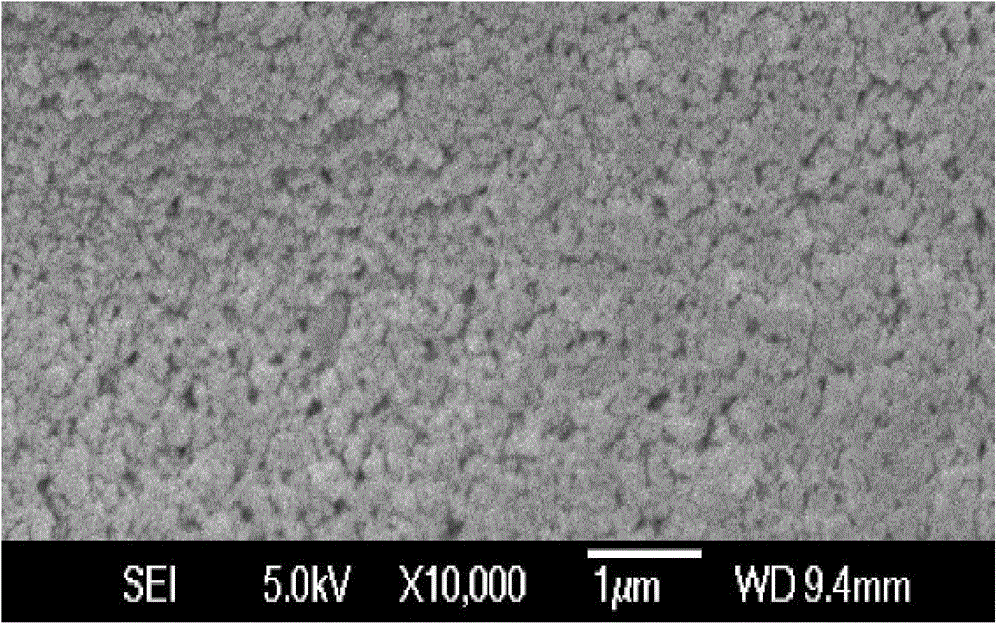A kind of synthesis method of highly dense phosphoric acid-based wave-transparent material
A phosphoric acid-based wave-transmitting and synthesis method technology, which is applied in the field of synthesis of wave-transmitting materials, can solve problems such as poor sealing, and achieve the effects of good sealing, not easy to break, and simple synthesis methods
- Summary
- Abstract
- Description
- Claims
- Application Information
AI Technical Summary
Problems solved by technology
Method used
Image
Examples
Embodiment 1
[0019] Weigh 3g of zinc oxide, 10g of alumina and 5g of zirconia and mix them in beaker 1, place them in an ultrasonic cleaner, weigh 15g of aluminum dihydrogen phosphate solution with a mass fraction of 85% in beaker 2, and add Add the mixture to beaker 2, then add 2 mL of nickel nitrate solution with a substance concentration of 0.05 mol / L and 2 mL of a ferric chloride solution with a substance concentration of 0.05 mol / L. After stirring with a glass rod, place it in the ultrasonic The ultrasonic mixing in the cleaner is uniform, the ultrasonic frequency is 40KHz, the temperature is controlled at 60~80℃, the ultrasonic vibration is dispersed for 2h, and the slurry is used as the precursor of the wave-transmitting material.
[0020] Soak the cut 46mm×102mm quartz fiber cloth in it. During this process, the ultrasonic frequency is changed to 20KHz. After soaking for 12 hours, it is taken out and calcined in a tube furnace. When calcining, the heating rate is 5℃ / min, and the temper...
Embodiment 2
[0022] Weigh 2g zinc oxide, 10g alumina, 3g silica, 5g zirconia and 3g titanium dioxide and mix them in beaker 1, place in an ultrasonic cleaner, weigh 20g of aluminum dihydrogen phosphate solution with a mass fraction of 85% in the beaker In 2, add the mixture in beaker 1 to beaker 2, then add 2 mL of nickel nitrate solution with a substance concentration of 0.05 mol / L and 2 mL of ferric chloride solution with a substance concentration of 0.05 mol / L. Use a glass rod After stirring, place it in an ultrasonic cleaner to ultrasonically mix uniformly, the ultrasonic frequency is 40KHz, the temperature is controlled at 60-80°C, the ultrasonic vibration is dispersed for 2h, and the slurry is used as the wave-transmitting material precursor.
[0023] Soak the cut 46mm×102mm quartz fiber cloth in it. During this process, the ultrasonic frequency is changed to 20KHz. After soaking for 12 hours, it is taken out and calcined in a tube furnace. When calcining, the heating rate is 5℃ / min, and...
Embodiment 3
[0025] Weigh 2g zinc oxide, 5g alumina, 3g silica, 7g zirconia and 3g titanium dioxide and mix them in beaker 1, place in an ultrasonic cleaner, weigh 15g of aluminum dihydrogen phosphate solution with a mass fraction of 85% in the beaker In 2, add the mixture in beaker 1 to beaker 2, then add 2 mL of nickel nitrate solution with a substance concentration of 0.05 mol / L and 2 mL of ferric chloride solution with a substance concentration of 0.05 mol / L. Use a glass rod After stirring, place it in an ultrasonic cleaner to ultrasonically mix uniformly, the ultrasonic frequency is 40KHz, the temperature is controlled at 60-80°C, the ultrasonic vibration is dispersed for 2h, and the slurry is used as the wave-transmitting material precursor.
[0026] Soak the cut 46mm×102mm quartz fiber cloth in it. During this process, the ultrasonic frequency is changed to 20KHz. After soaking for 12 hours, it is taken out and calcined in a tube furnace. When calcining, the heating rate is 5℃ / min, and ...
PUM
 Login to View More
Login to View More Abstract
Description
Claims
Application Information
 Login to View More
Login to View More - R&D
- Intellectual Property
- Life Sciences
- Materials
- Tech Scout
- Unparalleled Data Quality
- Higher Quality Content
- 60% Fewer Hallucinations
Browse by: Latest US Patents, China's latest patents, Technical Efficacy Thesaurus, Application Domain, Technology Topic, Popular Technical Reports.
© 2025 PatSnap. All rights reserved.Legal|Privacy policy|Modern Slavery Act Transparency Statement|Sitemap|About US| Contact US: help@patsnap.com

